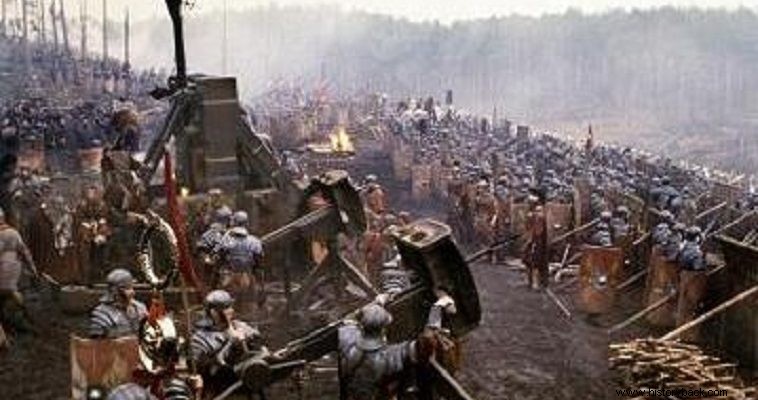
As reported by Thucydides in 429 BC during the siege of Plataea, the Spartans, unable to break the Plataean resistance with the use of battering rams and flaming arrows, decided to set fire to the wall and its wooden extension.
The Spartans collected a large amount of timber from coniferous trees. They poured resin and brimstone (sulfur) between the wood and lit a fire. The flame produced was unprecedented. It rose to a height of several meters, forcing the Plataean defenders to abandon the wall for safety. But apart from the blue flame that was burning the wooden extensions of the wall, the Plataeans had difficulty breathing, as poisonous gases were produced by the burning of sulphur.
Fortunately for them a sudden storm broke out and the heavy rain finally extinguished the fire. Four years later, in 424 BC. again during the Peloponnesian War, the Boeotians again used an incendiary device, the first functional flamethrower in history, against the Athenians at Delio.
The machine was simple to conceive. It consisted of three main parts, the launch tube, the container containing the incendiary material and the launch mechanism. The vessel was placed over a strong fire to keep the incendiary material – tar and sulfur – in a liquid state. From the left end of the tank started the ejection tube. At the other end was a large bellows.
When the bellows operated the incendiary material from the tube was channeled into the tube and through it into the enemy fortifications. As you can easily see, the range of this weapon was very short and the barrel had to be in contact almost with the target.
A similar device was used by the Spartan king Brasidas against the Athenians in the siege of the Lykythos fortress in Chalkidiki in 423 BC. In 360 BC Aeneas the Tactician, in his treatise on siege operations, advises the defenders to burn the attacked and their war machines with liquid tar. He even advised that sulfur be then poured over the top, so that the gases produced would poison the opposing soldiers.
Aeneas also speaks of incendiary bombs, wooden and spiked, which destroyed enemy siege engines. The strange thing was that these bombs, although wooden, contained incendiary materials. Apparently the bombs were set on fire just seconds before they were launched.
Various incendiary weapons were widely used in the famous siege of Lindos by Demetrius Poliorkites in 304 BC. Diodorus Siculus reports that in one night alone the Rhodians fired more than 800 incendiary missiles against the men of Demetrius Poliorkites.
The Romans then took over. Historians Tacitus and Silius the Italian mention the use of special catapult spears by the Roman army, who inserted long arrow-shaped projectiles soaked in liquid tar and sulphur. The Romans, following in the footsteps of the Greeks, also adopted the monogonous stone-throwing catapults, as machines for launching incendiary missiles.
These imposing machines, instead of the usual stone, put, probably properly shaped, "incendiary bombs", which were usually nothing more than clay pots filled with incendiary materials. An important development is reported by the war theorist of the 4th century AD. Vegetius.
Vegetius speaks of incendiary arrow-shaped catapult projectiles, but with a hollow wooden shaft, which was filled with sulfur, resin, tar and oil-soaked rope, which acted as a fuse.
Ammianus Marcellinus mentions that the wooden stems of these projectiles were reinforced with iron sheets, which had many holes at intervals, apparently to supply oxygen to the fire. These projectiles were placed in the launching machine.
Then the "shooters" lit the fuse and launched them. The fuse, during the "flight" of the projectile in the air, transmitted the fire to the "filling", which in turn ignited. If the gunner was experienced, he was able to time the launch so that the projectile ignited at the exact moment of contact with the enemy units. There is no information if these projectiles were explosive.
However, we should not rule out this possibility, since the ancients knew sulphur, nitre and, in general, nitrates and charcoal, i.e. the basic ingredients for the preparation of black gunpowder.
